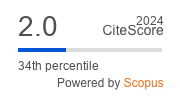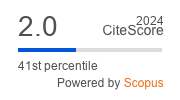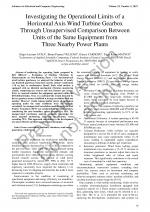| 2/2025 - 3 |
| Extra paper information in |
| Click to see author's profile in |
| Download PDF |
Author keywords
correlation, turbines, vibrations, wind energy generation, wind farms
References keywords
wind(32), turbine(14), review(12), energy(12), turbines(11), access(10), vibration(8), renewable(7), data(7), maintenance(5)
Blue keywords are present in both the references section and the paper title.
About this article
Date of Publication: 2025-06-30
Volume 25, Issue 2, Year 2025, On page(s): 19 - 26
ISSN: 1582-7445, e-ISSN: 1844-7600
Digital Object Identifier: 10.4316/AECE.2025.02003
Abstract
Considering the operating limits proposed by ISO 10816-21 Evaluation of Machine Vibration by Measurements on Non-Rotating Parts for horizontal-axis wind turbine gearboxes, we analyzed the behavior of nearly one hundred gearboxes from three nearby onshore wind farms (~10 sq km) in northeastern Brazil. Each wind turbine is equipped with an identical mechanical vibration monitoring system, comprising ten sensors and nine features per sensor. First, we assessed whether the equipment operated within the ISO-defined limits. Next, we confirmed the trends detected by the ten gearbox sensors exhibited a strong correlation with one another. However, trends among similar pieces of equipment operating under the same conditions were not strongly correlated. An unsupervised correlation analysis using the Fast Fourier Transform (FFT) was conducted for all wind turbines, considering the zone boundary values proposed by ISO. The unsupervised correlation analysis enhances knowledge for more targeted monitoring, achieving an accuracy score exceeding 70%. This approach contributes to the development of a more effective predictive maintenance program. |
| References | | | Cited By «-- Click to see who has cited this paper |
| [1] Global Wind Energy Council. Global wind report 2024. [online] https://www.gwec.net/reports/globalwindreport
[2] A. McCoy et al. Offshore Wind Market Report: 2024 Edition. Golden, CO: National Renewable Energy Laboratory. NREL/TP-5000-90525. [online] https://www.nrel.gov/docs/fy24osti/90525.pdf [3] H. Zuo, K. Bi, H. Hao, "A state-of-the-art review on the vibration mitigation of wind turbines," Renewable and Sustainable Energy Reviews, vol. 121, 109710, 2020. [CrossRef] [SCOPUS Times Cited 182] [4] F. Xie, A. M. Aly, "Structural control and vibration issues in wind turbines: A review," Engineering Structures, Engineering Structures, vol. 210, 110087, 2020. [CrossRef] [SCOPUS Times Cited 117] [5] M. A. López-Romero, M. S. Peñas, "A positive position feedback controller for vibration control of wind turbines," Energy Reports, vol. 9, 2023. [CrossRef] [SCOPUS Times Cited 16] [6] M. Sawant, S. Thakare, A. P. Rao, A. E. Feijóo-Lorenzo, N. D. budget, "A review on state-of-the-art reviews in wind turbine and wind farm related topics," Energies, vol. 14, 2041, 2021. [CrossRef] [SCOPUS Times Cited 46] [7] J. Chatterjee, N. Dyotheletes, "Scientometric review of artificial intelligence for operations and maintenance of wind turbines: The past, present and future," Renewable and Sustainable Energy Reviews, vol. 144, 111051, 2021. [CrossRef] [SCOPUS Times Cited 90] [8] S. B. Ramezani et al., "Scalability, explainability and performance of data-driven algorithms in predicting the remaining useful life," IEEE Access, vol. 11, pp. 41741-41769, 2023. [CrossRef] [SCOPUS Times Cited 23] [9] J. Guo, Z. Li, M. Li, "A review on prognostics methods for engineering systems," IEEE Transactions on Reliability, vol. 69, pp. 1110-1129, 2020. [CrossRef] [SCOPUS Times Cited 139] [10] M. S. Azari, F. Flammini, S. Santini, M. Caporuscio, "A systematic literature review on transfer learning for predictive maintenance in industry 4.0," IEEE Access, vol. 11, pp. 12887-12910, 2023. [CrossRef] [SCOPUS Times Cited 58] [11] G. G. B. Ferri et al., "Determining the trend behavior of the wind turbine powertrain using mechanical vibration and seasonal wind data," Energy Reports, vol. 13, pp. 353-362, 2025. [CrossRef] [SCOPUS Record] [12] R. Hai, C. Koutras, C. Quix, M. Jarke, "Data lakes: A survey of functions and systems," IEEE Transactions on Knowledge and Data Engineering, vol. 35, no. 12, pp. 12571-12590, 2023. [CrossRef] [SCOPUS Times Cited 55] [13] H. Badihi, Y. Zhang, B. Jiang, P. Pillay, S. Rakheja, "A comprehensive review on signal-based and model-based condition monitoring of wind turbines: Fault diagnosis and lifetime prognosis," Proceedings of the IEEE, vol. 110, no. 6, pp. 754-806, 2022. [CrossRef] [SCOPUS Times Cited 133] [14] K. Kong, K. Dyer, C. Payne, I. Hamerton, P. M. Weaver, "Progress and trends in damage detection methods, maintenance, and data-driven monitoring of wind turbine blades - A review," Renewable Energy Focus, vol. 44, pp. 390-412, 2023. [CrossRef] [SCOPUS Times Cited 85] [15] L. Cummins et al., "Explainable predictive maintenance: A survey of current methods, challenges and opportunities," IEEE Access, vol. 12, pp. 57574-57602, 2024. [CrossRef] [SCOPUS Times Cited 26] [16] E. Taherian-Fard, R. Sahebi, T. Niknam, A. Izadian, M. Shasadeghi, "Wind turbine drivetrain technologies," IEEE Transactions on Industry Applications, vol. 56, no. 2, pp. 1729-1741, 2020. [CrossRef] [SCOPUS Times Cited 42] [17] X. Jin, H. Wang, Z. Kong, Z. Xu, W. Qiao, "Condition monitoring of wind turbine generators based on SCADA data and feature transfer learning," IEEE Access, vol. 11, pp. 9441-9450, 2023. [CrossRef] [SCOPUS Times Cited 6] [18] M. Zheng et al., "Semi-supervised multivariate time series anomaly detection for wind turbines using generator SCADA data," Reliability Engineering & System Safety, vol. 235, 109235, 2023. [CrossRef] [19] S. Hong, T. Feng, J. Hu, X. Zhang, "Operation security prediction for wind turbines using convolutional neural networks: A proposed method," in IEEE Systems, Man, and Cybernetics Magazine, vol. 9, no. 1, pp. 4-9, 2023. [CrossRef] [20] T. Sun, G. Yu, M. Gao, L. Zhao, C. Bai, W. Yang, "Fault diagnosis methods based on machine learning and its applications for wind turbines: A review," IEEE Access, vol. 9, pp. 147481-147511, 2021. [CrossRef] [SCOPUS Times Cited 65] [21] M. Rezamand, M. Kordestani, R. Carriveau, D. S. -K. Ting, M. E. Orchard, M. Saif, "Critical wind turbine components prognostics: A comprehensive review," IEEE Transactions on Instrumentation and Measurement, vol. 69, no. 12, pp. 9306-9328, 2020. [CrossRef] [SCOPUS Times Cited 143] [22] G. Liu, J. Si, W. Meng, Q. Yang, C. Li, "Wind turbine fault detection with multimodule feature extraction network and adaptive strategy," IEEE Transactions on Instrumentation and Measurement, vol. 72, pp. 1-13, 3504613, 2023. [CrossRef] [SCOPUS Times Cited 23] [23] J. Xu et al., "Probabilistic prognosis of wind turbine faults with feature selection and confidence calibration," IEEE Transactions on Sustainable Energy, vol. 15, no. 1, pp. 52-67, 2024. [CrossRef] [SCOPUS Times Cited 12] [24] S. Kaiser, J. Carroll, A. McDonald, S. Weiss, "Comparison of wind turbine gearbox vibration analysis algorithms based on feature extraction and classification," IET Renewable Power Generation, vol. 13, pp. 2549-2557, 2019. [CrossRef] [SCOPUS Times Cited 29] [25] R. K. Pandit, D. Astolfi, I. D. Cardenas, "Review of predictive techniques used to support decision making for maintenance operations of wind turbines," Energies, vol. 16, 1654, 2023. [CrossRef] [SCOPUS Times Cited 23] [26] W. Jiang, J. Wu, H. Zhu, X. Li, L. Gao, "Paired ensemble and group knowledge measurement for health evaluation of wind turbine gearbox under compound fault scenarios," Journal of Manufacturing Systems, vol. 70, pp. 382-394, 2023. [CrossRef] [SCOPUS Times Cited 25] [27] A. Amin, A. Bibo, M. Panyam, P. Tallapragada, "Vibration based fault diagnostics in a wind turbine planetary gearbox using machine learning," Wind Engineering, vol. 47, pp. 175-189, 2023. [CrossRef] [SCOPUS Times Cited 26] [28] ISO 10816-21, Mechanical vibration - Part 21: horizontal axis wind turbines with gearbox, 2020, [online] www.iso.org/standard/60328.html [29] R. G. Pontius Jr, "Metrics that make a difference: How to analyze change and error," Springer, 2022. ISBN 9783030707644 [30] P. Duhamel, M. Vetterli, "FFT: A tutorial review and a state-of-the art," Signal Processing, vol. 19, pp. 259-299, 1990. [CrossRef] [SCOPUS Times Cited 842] [31] S. Liu, G. Li, H. Xie, X. Wang, "Correlation characteristic analysis for wind speed in different geographical hierarchies," Energies, vol. 10, 237, 2017. [CrossRef] [SCOPUS Times Cited 19] [32] J. Xu et al., "Probabilistic prognosis of wind turbine faults with feature selection and confidence calibration," IEEE Transactions on Sustainable Energy, vol. 15, pp. 52-67, 2024, [CrossRef] [SCOPUS Times Cited 12] [33] R. Igor, U. Ruslan, S. Aleksey, Approaches in Mathematical Modeling of Wind Turbines, Editor(s): Mohammad Reza Rahimpour, Encyclopedia of Renewable Energy, Sustainability and the Environment (First Edition), Elsevier, 2024, ISBN 9780323939416. [CrossRef] [SCOPUS Times Cited 1] [34] Y. Li, P. Wang, Z. Wu, Y. Su, "Collaborative monitoring of wind turbine performance based on probabilistic power curve comparison," Renewable Energy, vol. 231, 120919, 2024. [CrossRef] [SCOPUS Times Cited 2] [35] M. R. Machado, M. Dutkiewicz, "Wind turbine vibration management: An integrated analysis of existing solutions, products, and Open-source developments," Energy Reports, vol. 11, pp. 3756-3791, 2024. [CrossRef] [SCOPUS Times Cited 20] Web of Science® Citations for all references: 0 SCOPUS® Citations for all references: 2,260 TCR Web of Science® Average Citations per reference: 0 SCOPUS® Average Citations per reference: 63 ACR TCR = Total Citations for References / ACR = Average Citations per Reference We introduced in 2010 - for the first time in scientific publishing, the term "References Weight", as a quantitative indication of the quality ... Read more Citations for references updated on 2025-06-30 13:44 in 205 seconds. Note1: Web of Science® is a registered trademark of Clarivate Analytics. Note2: SCOPUS® is a registered trademark of Elsevier B.V. Disclaimer: All queries to the respective databases were made by using the DOI record of every reference (where available). Due to technical problems beyond our control, the information is not always accurate. Please use the CrossRef link to visit the respective publisher site. |
Faculty of Electrical Engineering and Computer Science
Stefan cel Mare University of Suceava, Romania
All rights reserved: Advances in Electrical and Computer Engineering is a registered trademark of the Stefan cel Mare University of Suceava. No part of this publication may be reproduced, stored in a retrieval system, photocopied, recorded or archived, without the written permission from the Editor. When authors submit their papers for publication, they agree that the copyright for their article be transferred to the Faculty of Electrical Engineering and Computer Science, Stefan cel Mare University of Suceava, Romania, if and only if the articles are accepted for publication. The copyright covers the exclusive rights to reproduce and distribute the article, including reprints and translations.
Permission for other use: The copyright owner's consent does not extend to copying for general distribution, for promotion, for creating new works, or for resale. Specific written permission must be obtained from the Editor for such copying. Direct linking to files hosted on this website is strictly prohibited.
Disclaimer: Whilst every effort is made by the publishers and editorial board to see that no inaccurate or misleading data, opinions or statements appear in this journal, they wish to make it clear that all information and opinions formulated in the articles, as well as linguistic accuracy, are the sole responsibility of the author.



